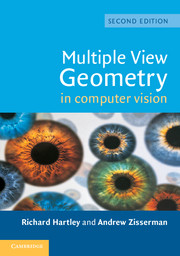Book contents
- Frontmatter
- Contents
- Foreword
- Preface
- 1 Introduction – a Tour of Multiple View Geometry
- PART 0 The Background: Projective Geometry, Transformations and Estimation
- PART I Camera Geometry and Single View Geometry
- PART II Two-View Geometry
- PART III Three-View Geometry
- PART IV N-View Geometry
- PART V Appendices
- Bibliography
- Index
1 - Introduction – a Tour of Multiple View Geometry
Published online by Cambridge University Press: 25 January 2011
- Frontmatter
- Contents
- Foreword
- Preface
- 1 Introduction – a Tour of Multiple View Geometry
- PART 0 The Background: Projective Geometry, Transformations and Estimation
- PART I Camera Geometry and Single View Geometry
- PART II Two-View Geometry
- PART III Three-View Geometry
- PART IV N-View Geometry
- PART V Appendices
- Bibliography
- Index
Summary
This chapter is an introduction to the principal ideas covered in this book. It gives an informal treatment of these topics. Precise, unambiguous definitions, careful algebra, and the description of well honed estimation algorithms is postponed until chapter 2 and the following chapters in the book. Throughout this introduction we will generally not give specific forward pointers to these later chapters. The material referred to can be located by use of the index or table of contents.
Introduction – the ubiquitous projective geometry
We are all familiar with projective transformations. When we look at a picture, we see squares that are not squares, or circles that are not circles. The transformation that maps these planar objects onto the picture is an example of a projective transformation.
So what properties of geometry are preserved by projective transformations? Certainly, shape is not, since a circle may appear as an ellipse. Neither are lengths since two perpendicular radii of a circle are stretched by different amounts by the projective transformation. Angles, distance, ratios of distances – none of these are preserved, and it may appear that very little geometry is preserved by a projective transformation. However, a property that is preserved is that of straightness. It turns out that this is the most general requirement on the mapping, and we may define a projective transformation of a plane as any mapping of the points on the plane that preserves straight lines.
Information
- Type
- Chapter
- Information
- Multiple View Geometry in Computer Vision , pp. 1 - 22Publisher: Cambridge University PressPrint publication year: 2004
Accessibility standard: Unknown
Why this information is here
This section outlines the accessibility features of this content - including support for screen readers, full keyboard navigation and high-contrast display options. This may not be relevant for you.Accessibility Information
- 4
- Cited by
